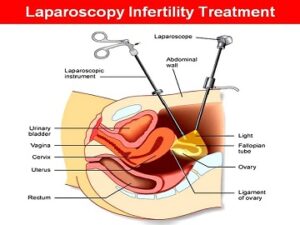
Laparoscopy is a surgical procedure involving one or two small incisions through which a laparoscopic surgeon inserts a laparoscope(a thin, fibre-optic tube fitted with a light and a camera) and specialized surgical instruments into the abdomen. This procedure allows your doctor to gain a clear view of the abdominal and pelvic organs including the uterus, fallopian tubes and ovaries.
Laparoscopy is an effective minimally invasive technique used to view, repair or remove damaged tissue. Though the use of this technique was initiated in as early as the 1900s, more advanced techniques were developed in the 1960s when laparoscopy began to be considered a safe procedure. In the last decade or so the use of laparoscopy has expanded and it is increasingly being adopted for diagnosis and treatment of various reproductive disorders including pelvic adhesions, polycystic ovaries, endometriosis and disorders of the fallopian tubes. Surgeries that once required very large abdominal cuts and long hospital stays can now be performed with incisions only up to 1.5 cm in length.
Some key benefits of laparoscopic surgery are:
- Less blood loss, reducing the need for blood transfusion
- Smaller incisions and thus smaller scars
- Less pain
- Shorter recovery time and hospital stay
Here is a look at when a laparoscopy may be suggested for a patient.
Laparoscopy for diagnosis of infertility
Laparoscopy is useful in diagnosing the cause of infertility in a patient, but it is usually performed only after other infertility testing has been done. The procedure is used for identifying factors which could be causing infertility or delayed pregnancy such as cysts, adhesions, fibroids and infection in the reproductive tract. In some patients with pelvic pain, laparoscopy may be used to determine and treat the source of pain such as adhesions or scar tissues. Blockage in the fallopian tubes can be easily detected through laparoscopy.
Laparoscopic surgery for endometriosis
Endometriosis is a condition in which endometrial tissue (tissue that lines the uterus) appears outside the uterus and can lead to pain, bowel problems and infertility. Laparoscopy is the most frequently used procedure in diagnosis and removal of endometriosis(please add link to Blog 19: Endometriosis and infertility when it is published) growth in mild to moderate cases. Laparoscopy is recommended so that the internal organs can be clearly viewed to identify endometrial growths since this is the only technique through which endometriosis can be diagnosed with total certainty. Any visible endometriosis implants and scar tissues that may be causing pain or infertility are also removed through this process.
Laparoscopy in treatment of Polycystic Ovarian Disease (PCOD)
PCOD is a condition where a woman’s hormonal levels (estrogens and progesterone) go out of balance. This causes development of benign cysts on one or both ovaries. PCOD disrupts menstruation and ovulation (monthly release of egg by the ovary), and is therefore a leading cause of infertility in women. The procedure to treat PCOD through laparoscopy is known as ‘ovarian drilling’ where a small needle bearing electric current is used to drill small holes on the surface of the ovary to promote ovulation.
Laparoscopy for ectopic pregnancy
Ectopic pregnancy is said to occur when an embryo implants in a place outside of the uterus, such as in one of the fallopian tubes. Surgical removal of an ectopic growth and/or in certain cases the section of fallopian tube where the embryo has implanted is the fastest and most effective treatment for ectopic pregnancy. If the ectopic pregnancy has not caused rupture of the fallopian tube, the doctor removes the pregnancy without removing or damaging the tube.
Now let us examine a few commonly asked questions about the procedure:
Is this a major procedure? How much time does the recovery take?
Laparoscopy is a relatively simple procedure. Diagnostic laparoscopy takes between 30 minutes and one hour. Laparoscopic surgeries take longer.
Laparoscopy may be performed under general or local anaesthesia. Once laparoscopy is complete the patient is put under observation for a few hours and generally released on the same day. In some cases the patient may need to remain overnight. Since very small incisions are made, recovery is quick and patients can normally return to their daily activities within one week of surgery. Postoperative pain also generally resolves within a few days.
What can a patient expect immediately after surgery?
Some patients may experience nausea, light-headedness, mild pain around the incisions, abdominal or uterine cramping and some amount of vaginal bleeding or discharge. The symptoms generally subside within a couple of days.
Are there any complications associated with the procedure?
The risk of complications is negligible when the procedure is done by an expert. Known complications include inflammation of the abdominal wall, or damage to other structures in the pelvis such as the bladder or bowel. As with any other surgery, anaesthesia related complications are a possibility.
For effectiveness of laparoscopic surgery for treating various issues discussed above, the skill and expertise of the surgeon is critical and therefore we advise you to choose the clinic or doctor for such procedures with a lot of care.
Dr Manika Khanna is an award winning Infertility Specialist and Laparoscopic Surgeon who founded the Gaudium Infertility Clinic chain in 2009. The centre provides best in class laparoscopic surgery services with ultramodern infrastructure and latest know-how in the field.



